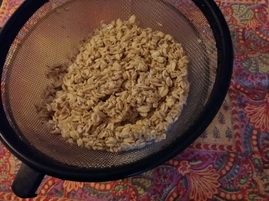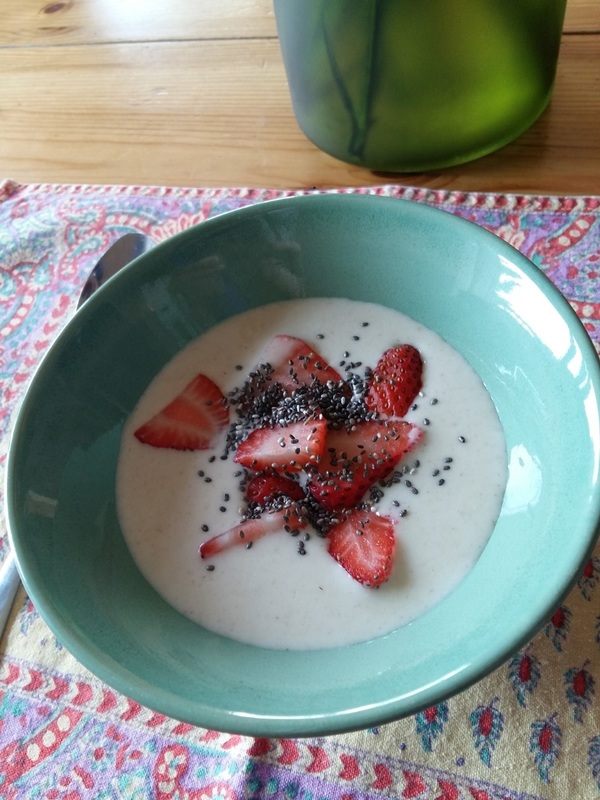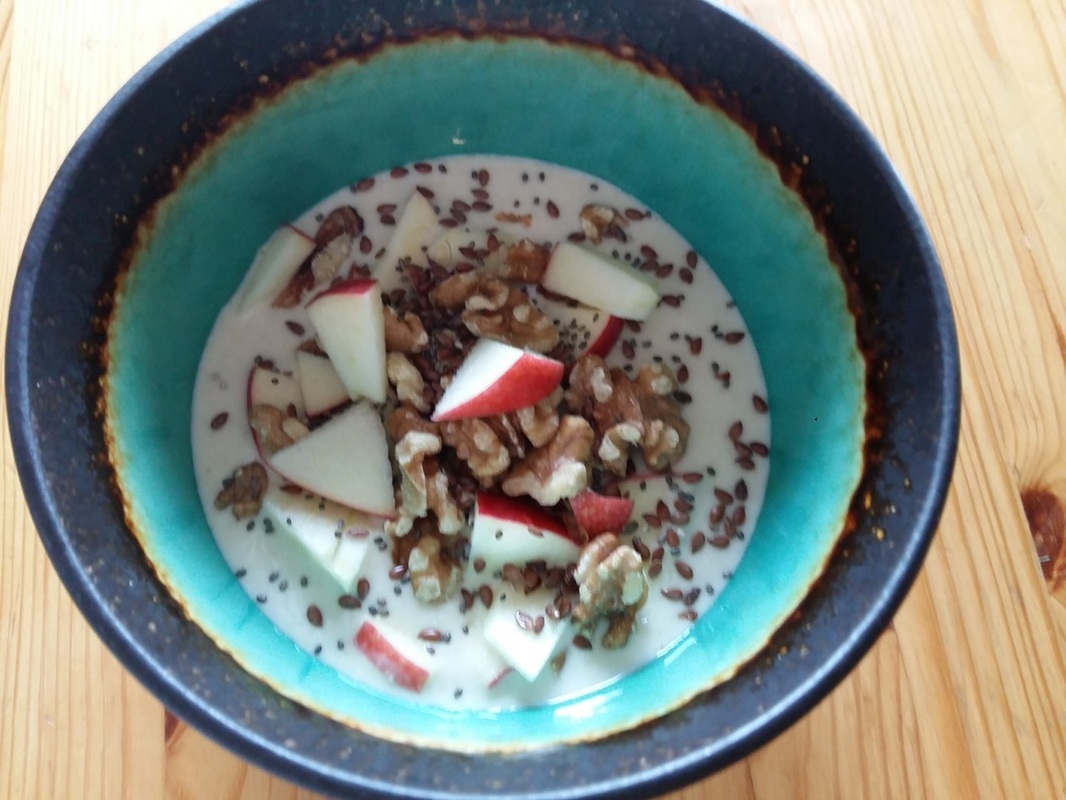
This week was my first attempt at oatgurt, you got it folks, fermented super creamy oats! Ive made many nut yoghurts before but this was the first experimental recipe with the oats. Looking back at all the nutgurts I attempted, it took a few times to get the recipe down, not that the first attempts weren't edible, they were just a little runny, or under/over cultured, then I started nailing it and creating better recipes with blends like cashew coconut, or almond vanilla. Most of these nutgurts need some sort of starch or flour to thicken so I turned to hemp or pumpkin protein for a thickener but these flavours are apparent, not unpleasant, but not exactly yogurt tasting. if I remember yogurt correctly..
They never really got that strong tangy taste, just a subtle, searchable one.
The very simple oatgurt recipe is the closest thing I think I would peg to that tangy, light on the tongue taste. But as my taste tester in the house isn't a yogurt guy to begin with, he had nothing to compare to except a faint memory as well so I'd love some feedback on this one.
One of my hesitations with making oatgurt was the starchy consistency it already has, the gooey stuff that hovers over the oats while they cook on the stove. To get rid of a lot of this, and some of the antinutrients, like phytic acid in the oats I soaked them for a good long while, rinsing them when I thought, "it's been a while"..
Oats, as we often think of them, are made from the hulled seeds of a cereal grain that is scientifically called Avena Sativa. As one of the most hardy plants in their class, oats are known for their incredible ability to flourish in poor soil and survive harsh weather conditions. These characteristics have made oats a highly valuable crop for many traditional cultures, particularly those settled in climates with volatile or unpredictable growing seasons, which turns us to modern times and oats being one of the top 5 cereal grains grown in Canada today, suited to our colder northern climate.
In their whole form, oats are high in B vitamins including thiamine, riboflavin, niacin, pantothenic acid and folate. They also have an impressive mineral profile with significant amounts of calcium, iron, phosphorous, magnesium, and zinc. Naturally gluten-free, oats contain a unique soluble globulin protein that is much easier to digest than that found in other grains and far less irritating to the digestive tract. The soluble fiber content also contributes to improved digestive process and helps promote detoxification processes within the body. Oats include a powerful class of antioxidants called avenanthramides that have been shown in several studies to reduce inflammation when ingested or even when used topically on the skin.
The plant world is inherently smart, protecting themselves against degradation or being digested by having a hard outer layer that is not easily broken down by the highly acidic nature of human or animals stomachs. Besides the hulls, or outer layers, cereal grains, bean, and legumes contain things like phytates, these phytates bind to the minerals within the grains, beans, or legumes rendering them unusable. One way to lower or neutralize these antinutrient compounds is to be a ruminant animal with high levels of bacteria producing phytase, or to traditionally prepare them. To read more about traditional preparations , why it's important and how it can be done, click here. In general, humans do not produce enough phytase to safely consume large quantities of high-phytate foods on a regular basis. However, probiotic lactobacilli, and other species of the endogenous digestive microflora can produce phytase. It seems to make sense to me to help the bacteria that can produce phytase to flourish.
So maybe turning oats into yogurt isn't a traditional preparation but it starts out that way and it promotes the multiplication of helpful bacteria. Soaking them overnight in an acidic medium, this can be as simple as adding a teaspoon of apple cider vinegar to the water, can lower the phytic acid content in the oats, allowing more of the minerals to be absorbed by us. Simply soaking them is a good idea, but making sure there is a suitable amount of lactobacilli to produce phytase that will further render phytic acid inactive is an even better idea, this means sprouting, souring, or adding foods high in its content.
Although phytase is present in small amounts in oats, heat treating to produce commercial oatmeal renders it inactive. Even grinding a grain too quickly or at too high a temperature will destroy phytase, as will freezing and long storage times. Traditional cultures generally grind their grain fresh before preparation.
It would be great to have a grinder and process my own grains, however, I'm not there yet! I soak to make porridge, and now I'm "souring" it, loving it, and nom nom noming it!
I soaked and rinsed a good 36hrs, I don't think this is completely necessary as I've seen other recipes that call for just 8 hrs, or "overnight".
During the last rinse I sprinkled a capsule of non dairy lactobacillus over the oats before blending them, I'm not sure if this is entirely necessary because the fermenting process alone encourages lactobacillus culture, but I love those little guys and my gut does too!
In a Blender I added the oats and equal parts of filtered water, next time I will cut the liquid by 1/4 as the oatgurt turned out not as firm as I would like, but I'll let you know how that goes. Blended for a good few minutes because I was concerned it might turn out grainy, which it didn't at all, fewf!
The next day I took a little out just to taste test it, I used a wooden spoon because I know with the kombucha, it doesn't like metal utensils, I'm assuming the bacteria in the oats don't either. I'll tell you, my prediction of a starchy sweet flavor revealed itself and I was thinking at least the organic oats were less than $1 so it wasn't the biggest loss. It was also quite liquidy and more of a drink consistency than a "gurt".. I slipped it back into the cupboard and definitely didn't expect much.
Day 2 taste test, a subtle tangy flavour appeared, less starchy, and lighter on the tongue. More of a "pudding" or thick "sauce" consistency but better than the runny looking concoction from the day before.
Day 3 taste test, wow! What turn around from being a bit disappointed to fascinated with the metamorphosis of flavour. Smooth and light, no longer a starchy goo, it had thickened up to the consistency of a runny "gurt" that I found more than than just edible, I found quite delicious.
I liked it so much I left it in the cupboard for the rest of that day but slipped it into the fridge that evening, to stop the fermentation process. I hit the sweet spot of tangy fermentation that was delightful to my tongue. I've seen recipes call for anywhere from 2-5 days, in my house, with my tastes, my was perfection at day 3.
I also see recipes that add some kind of sugar to the oatgurt, this one has none, and even though I like a little sweetness in life, I didn't even add it to the finished bowls of healthy oatgurt. One bowl I ate with a cut up apple some walnuts, flax and chia seed, delish! Another topped with the last of the season strawberries, so yummy.
yogurts, nutgurts, oatgurts add such great beneficial bacteria to our own microflora, and they help us in so many ways, from breaking down certain carbohydrate, making vitamins, producing serotonin that makes us feel good, and contributing to better digestion and immune health. Including traditionally fermented foods in our diets on a regular basis with help keep our microflora balanced and happy, so we can be balanced and happy.
We all know that marketing and commercial hype of these foods is just that, with added sugars, pasteurization, and questionable culture counts, it's hard to find a truly healthy commercial brand of of these foods. If you're buying these; source small producers, know the maker, or best of all make it yourself for an organic 100% live bacterial culture count. Nourish your soul by nourishing yourself.
If you're interested in starting to make nutgurts, oatgurts, kombucha, and other fermented goodies, or ways to boost your microflora for gut health, call 782 234 9453. There are group rates for sessions so get some friends together for a fermenting party!
Much Health,
~Rebecca

